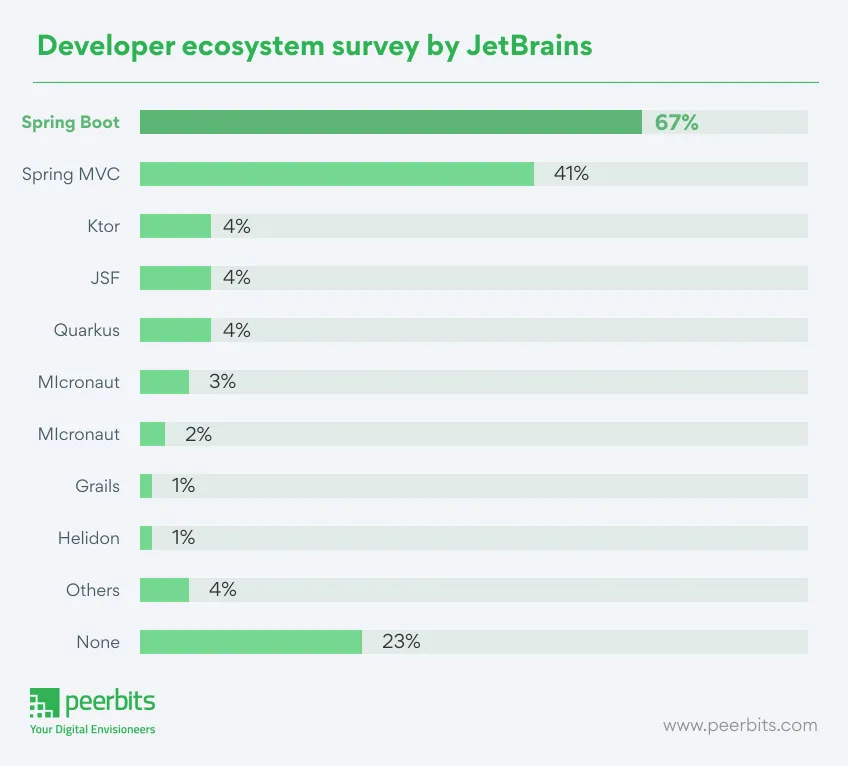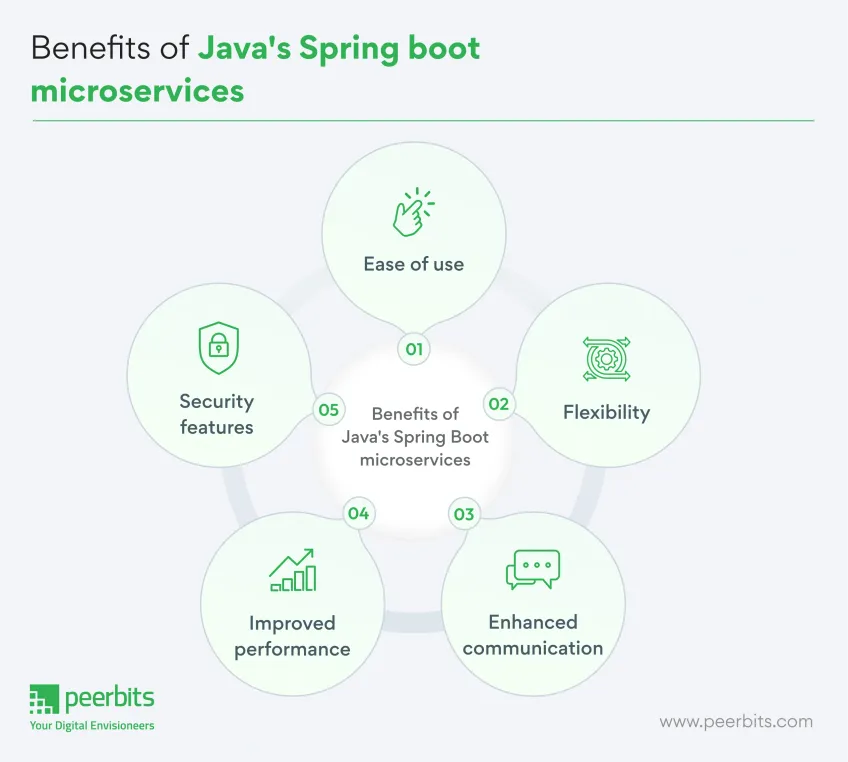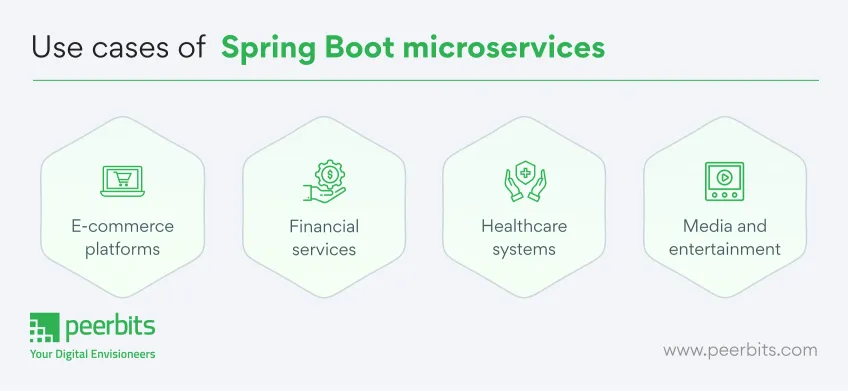Nowadays, microservices have become ‘that’ popular kid of the group that everyone ignored before! The credit for its immense popularity goes to microservice’s significant impact on the scalability and flexibility of applications. One incredible way to build microservices is with Spring Boot, a Java-based framework that simplifies the process of setting up and deploying applications.

Based on a recent developer ecosystem survey by JetBrains, Spring Boot, and Spring MVC are the most used web frameworks for Java development. As of now, data from Theirstack shows that 37,884 companies across 117 countries use Spring Boot, with major adoption seen in the United States, India, and the United Kingdom.
So, if you're curious about how Spring Boot microservices can make a difference in your development journey, then you've landed at the right place. This guide dives deeper into the insights about Spring Boot microservices, ranging from understanding the basics to exploring the benefits, use cases, future trends, and categories of businesses that should choose this newer approach. Let’s begin the ride.
What are Spring Boot microservices?
Spring Boot microservices refer to a modular approach to building applications using the Spring Boot framework of Java. These days, instead of traditional monolithic applications where all features are tightly coupled into one package, companies prefer to build small, independent services aka microservices with Java’s Spring Boot framework.
For those who are wondering what’s so crazy about microservices? Well, each microservice focuses on a single business capability and can be developed, tested, deployed, and scaled independently of others. It suggests that you can adopt a more flexible development process and make the maintenance of complex applications much easier just with a simple shift in your development approach.
Over this awesome approach, Spring Boot provides a variety of tools and libraries as an added resource for Java developers. With embedded servers, auto-configuration options, and production-ready features, the Spring Boot framework of Java streamlines the entire development process into an easy-peasy ride. Well, still skeptical about choosing Spring Boot for building microservices? Follow along for some more solid reasons!
Why choose Spring Boot for microservices?

Java’s Spring Boot is a top choice for developing microservices for several reasons as follows:
-
Quick start: It simplifies the setup process by providing default configurations, reducing the boilerplate code developers have to write. It is a lifesaver, especially when you want a quick start in microservices up and running with minimal fuss.
-
Extensive ecosystem: Spring Boot’s extensive ecosystem integrates seamlessly with other Spring projects, like Spring Cloud known for building distributed systems. You get tools for service discovery, configuration management, circuit breakers, and more with Spring Cloud.
-
Ease of Inter-service communication: Spring Boot supports inter-service communication. It happens when microservices need to communicate with each other, and Spring Boot comes in to offer multiple options for this, including REST, gRPC, and messaging queues. With this developers can choose a variety of options based on their requirements.
How Java helps in microservices development?
Java is a widely used programming language known for its security and platform independence. Its mature ecosystem and extensive library support make it an excellent choice for developing microservices. Whereas the Spring Boot framework of Java strengthens this architecture, even further adding scalability and maintenance to its feature shelf.
Some of Java's key advantages in the context of microservices are:
-
It's multithreading support. In this, you can run multiple processes concurrently. This comes in handy especially when your goal is to build responsive and scalable applications.
-
Java’s concurrency also makes it perfect for handling multiple microservices that need to operate in tandem without slowing down the entire system.
-
Java’s extensive error-handling mechanisms guarantee the reliability of microservices built with Spring Boot.
Advantages of Java’s Spring Boot microservices

There are several benefits of Spring Boot microservices that are ranking it always on top of the charts of preferences from various IT giants. Here are some of the reasons for its spectacularity:
-
Ease of use: Spring Boot’s auto-configuration capabilities allows the develoeprs to quickly set up microservices instead of fussing over the underlying infrastructure. Once you hire offshore Java developers you can be free from all the hard work.
-
Flexibility: Everyone’s understood that each microservice can be developed independently. But when this flexibility extends to deployment, that’s when it gets interesting. Different services can be scaled according to their specific needs only because- microservices are highly flexible!
-
Enhanced communication: With Spring Boot, inter-service communication is finally sorted. As many struggle over its security and seamlessness. But even in a complex distributed system, it becomes a smoother sea to sail due to Spring Boot.
-
Improved performance: Java’s performance optimizations and Spring Boot’s lightweight nature together make the execution times much faster and lower the resource consumption. For businesses who want to handle high loads without degrading performance, this is your pointer to keep in mind.
-
Security features: Spring Boot comes with built-in security features that protect microservices from common vulnerabilities. Java’s strong type-checking at compile-time also gives applications an extra layer of security reducing chances of error that could lead to security breaches.
Which Businesses can Benefit from Spring Boot Microservices with Java?

Businesses of all sizes and industries can benefit from using Spring Boot microservices with Java. Here are some of the substantial sectors that should consider Spring Boot for their business growth:
-
E-commerce businesses: E-commerce platforms that need to manage various functions like user authentication, payment processing, inventory management, and order fulfillment can take huge advantage of Spring Boot microservices. You can easily scale specific parts of the application based on demand reducing the risk of downtime and staying on edge with the competition.
-
Financial institutions: Banks, insurance companies, and other financial institutions can also gain a massive benefit from Spring Boot microservices for handling different aspects of their operations. Given the high demand for security and reliability in this sector, microservices can easily help firms deploy updates and enhancements without interrupting other services, thus maintaining high availability and compliance with regulatory standards.
-
Healthcare providers: The healthcare sector can benefit from Spring Boot microservices by organizing their various services, like patient management, appointment scheduling, billing, and medical records, into separate microservices. This separation allows healthcare providers to make sure data integrity, maintain high performance, and comply with privacy regulations like HIPAA. It also promotes easier updates and scaling based on patient needs and operational demands.
-
Media and entertainment companies: Companies involved in streaming, content distribution, and digital media can use Spring Boot microservices to manage different functionalities such as content management, user preferences, subscription services, and analytics. By breaking down these features into microservices, these companies can deliver a seamless user experience while efficiently managing backend services.
Technological advancements and features
Some of the latest trends in Spring Boot of Java that you should keep an eye on are:
Latest features and enhancements
-
Spring Boot 3.2 supports Java 21’s virtual threads, which many Java programmers prefer over traditional threads.
-
GraalVM for building native images. They also help reduce the startup time and memory footprint.
-
The latest releases also include Spring Boot’s support for Java 21, Spring Framework 6.1.3, and Spring Data JPA 3.1.3.
Integration and ecosystem
-
Spring Boot’s integration with popular libraries and tools, such as embedded Tomcat, Jetty, and Undertow servers, enhances its utility for developers
-
The framework also supports extensive tools for seamless integration with messaging systems like JMS, AMQP, RabbitMQ, Kafka, and Pulsar, simplifying the creation of message-driven microservices
Future trends and predictions
Some of the emerging trends in microservices are:
-
Adoption of CNCF standards.
-
New app layer protocols replacing HTTP REST,
-
Rise of polyglot frameworks
Additionally, cloud engineering using DevSecOps and API-driven infrastructure is also becoming quite prevalent in handling multiple cloud platforms.
Some of the predictions for Spring Boot that you can expect to oversee in the future involve Spring Boot framework’s support for reactive programming, serverless architecture, and integration with monitoring tools like Micrometer that also further enhance its adoption in future.
Conclusion
Spring Boot microservices with Java offer a flexible, efficient, and scalable solution for building modern applications. With the use of manageable services, businesses can reduce complexity, improve performance, and adapt to changing needs more easily. It doesn’t matter whether you're running a startup or managing a large enterprise, adopting Spring Boot microservices can provide some promising benefits that have been discussed above. With its strong integration with Java, a wide variety of tools, and a vibrant community, Spring Boot is an excellent choice for microservices architecture. You can hire dedicated Java developers to harness the power of your microservices.
By understanding how to effectively use these tools, you can create applications that are not only efficient but also responsive to the needs of your users. However, not everything has to be done alone! You can take charge in this competitive era with the help of reliable offshore Java developers and check how your businesses are perfect with just a small and simple shift in your frameworks.









